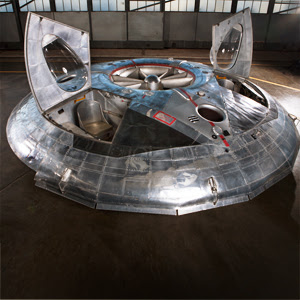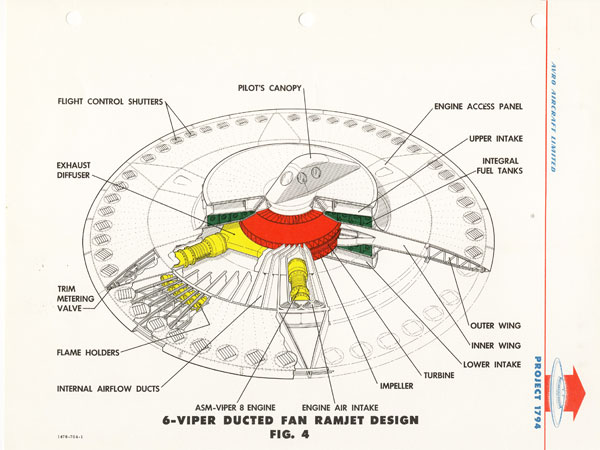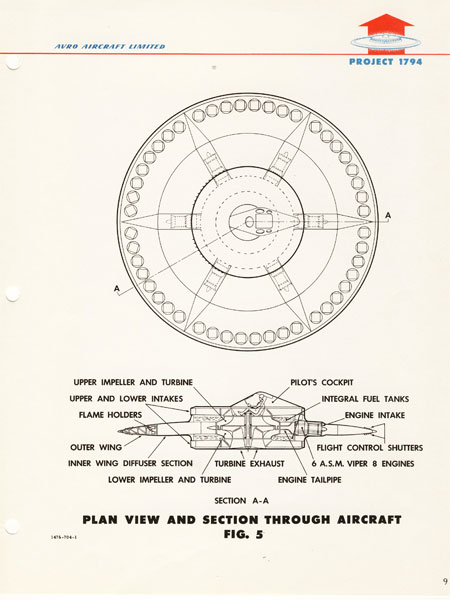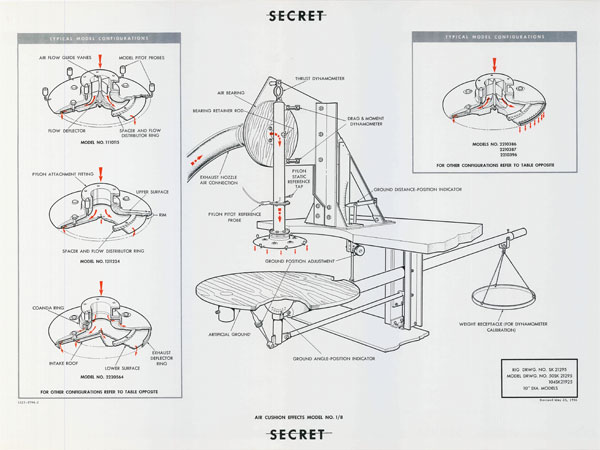 In the 1950s, a small team of engineers set to work on a secret program called Project 1794—a supersonic craft designed to shoot down Soviet bombers. Now a trove of declassified documents reveals the audacious mission to build a flying saucer.
In the 1950s, a small team of engineers set to work on a secret program called Project 1794—a supersonic craft designed to shoot down Soviet bombers. Now a trove of declassified documents reveals the audacious mission to build a flying saucer.
In September 2012, Michael Rhodes, a technician at the National Declassification Center (NDC) in College Park, Md., donned white cotton gloves, entered a climate-controlled room, and opened a cardboard file box. It was time for the report inside—"Project 1794 Final Development Summary Report 2 April—30 May 1956"—to become public.
Rhodes's job is to read such documents, catalog them, and make them available to historians, journalists, and the curious. The paper was crisp, like new. Rhodes began to read.
He soon realized that the file box contained highly unusual material. "As I was processing the collection, I glimpsed this weird red flying-disc icon in the corners," Rhodes says. Inside the box was a trove of oddities: cutaway schematics of disc-shaped aircraft, graphs showing drag and thrust performance at more than Mach 3, black-and-white photos of Frisbee shapes in supersonic wind tunnels. The icon was a flying saucer on a red arrow—the insignia of a little-known and strange sideshow in aeronautical design. Rhodes was leafing through the lost records of a U.S. military flying saucer program.
A Canadian aviation firm began developing a disc-shaped aircraft for the U.S. military in the mid-1950s, and, though the details were secret, the project itself was not unknown. POPULAR MECHANICS mentioned the Air Force's "vertical-rising, high-speed" craft in 1956 and published a photo in 1960. In the decades since the program was canceled in 1961, aviation buffs and UFO researchers have unearthed technical papers written near the end of America's flying saucer experiment, but the document that originally convinced the government to invest in a military flying disc has languished in the NDC under the SECRET designation. This recently discovered report describes in previously unknown detail how aviation engineers tried to harness what were then cutting-edge aerodynamic concepts to make their improbable creation fly. Although Avro's saucer never completed a successful flight, some of the most sophisticated aircraft flying today adopted many of the same technologies.
In 2001, U.S. Air Force personnel cleared the document cache for public release, according to Neil Carmichael, director of the declassification review division at the NDC, which is run by the National Archives and Records Administration. But it took 11 years to crack open the boxes in College Park and glimpse the saucer secrets within—the staff is buried in a backlog of nearly 2 billion pages of declassified material, some of it dating to World War II. "These records probably have been classified since their creation," Carmichael says. "It's like somebody emptied out a filing cabinet, stuck it in a box, sealed it, and sent it off to the federal records center."
In pop culture, flying saucers are the ride of choice for extraterrestrials. What the newly released documents show is that they actually came from Ontario, Canada. That's where a visionary aeronautical engineer at the now-defunct Avro Canada convinced his bosses to support the unlikely project. "During the Cold War the Army, Air Force, and Navy were experimenting with all sorts of things," Carmichael says. As the NDC releases its declassified documents, "the records are going to tell the rest of those stories." The most sensational of the disclosures so far—Project 1794.
Saucer Full of Secrets: Pics From Declassified Military Docs
See more at: http://www.popularmechanics.com/technology/military/research/saucer...
Frost's Flying Discus
Avro Canada hired John "Jack" Frost in 1947, tapping the 32-year-old for a program to develop a supersonic aircraft called the Avro Arrow. While working on the Arrow program, Frost conducted experiments in the Avro labs on the way airflow tends to stick to gently curved surfaces, a phenomenon called the Coanda effect. The results showed that engine exhaust could be routed across the fuselage to the area just beneath a saucer, where it would form a cushion of air on which the craft could hover. Palmiro Campagna, an author and engineer with the Canadian Department of National Defence, wrote a book about Avro, Requiem for a Giant. "Frost believed that the Germans had developed some form of flying saucer—like aircraft," he says. "Part of that belief stemmed from stories and newspaper articles that appeared back in the 1950s."
The stories turned out to be bogus, but to Frost they seemed reasonable. During World War II, Hitler's engineers had outpaced the Allies in developing ballistic rockets and jet airplanes, and those advances had become spoils of war exploited by both the Soviet Union and the United States. Frost worried that equally important flying-disc technology could have been secreted away by Moscow. "He didn't want North Americans to lag behind," Campagna says.
After Frost talked up the results of his lab research to Omond Solandt, the head of the Canadian Defence Research Board, the government official introduced him to decision-makers in the Pentagon. Then, as now, the big money in military contracting was in the United States.
The American military was seeking a supersonic aircraft that could take off from primitive airfields to intercept Soviet long-range bombers. By 1955, the United States was ready to fund a million-dollar feasibility study. Aviation historians say they aren't surprised that the concept, which seems outlandish today, had proponents at the time. "The flying saucer configuration offers benefits," says Russell E. Lee, a curator at the Smithsonian National Air and Space Museum in Washington, D.C. "It's totally symmetrical, so in theory it should be omnidirectional—if you can figure out how to redirect thrust in an instantaneous and efficient manner. Putting myself in the shoes of the designers in the early '50s, I would think it would be a viable candidate for further investigation."
Frost's design was detailed in a 117-page report—the same document that ultimately was unearthed by the NDC. The proposed craft featured a central turbine, called a turborotor, powered by six turbojet engines. The turborotor sucked in air that was directed through the body of the aircraft. The exhaust exited from vents placed along the circumference of the aluminum saucer; vanes and shutters directed the exhaust toward the ground to hover.
The engineers predicted that the 20,000 pounds of thrust produced by the jets' exhaust could be directed downward all around the disc's perimeter. "This jet-around-wing configuration produces a powerful take-off ground cushion so that the lift on the aircraft is increased to possibly 30,000 lb.," the report says, "and the aircraft rises to about 20 feet." Once in the air, the saucer's pilot would reroute the exhaust to one side of the craft to move laterally. The documents reveal the extravagantly rose-colored aspirations of the researchers. Frost predicted the saucer would travel at Mach 4 with "a ceiling of over 100,000 feet and a maximum range ... of about 1000 nautical miles."
The Air Force and Army agreed to fund prototypes, and Avro had Frost set up a secret facility for construction and testing. The special projects group (SPG) was located at the Avro plant in Malton, Ontario, northwest of Toronto. Avro Canada, which employed 14,000 people at its height, spread its operations over several large buildings, empty lots, and aircraft hangars. (Today the location is adjacent to Toronto's Pearson International Airport.) Frank Harvey, current president of the Aerospace Heritage Foundation of Canada, worked on an Avro aircraft assembly line from 1956 to 1959. He was not part of SPG and recalls wondering what was going on within its walls. "Very few people got in there," he says. "If you walked anywhere near, there were security guards."
The precautions were well-founded. Soviet-era notes from a KGB major named Vasili Mitrokhin confirm that a spy did in fact operate at the Avro facility, seeking information on the Arrow program. Campagna says the Royal Canadian Mounted Police discovered the spy's identity but never disclosed the name.
Source: Popular Mechanics - See more at:http://www.riseearth.com/2013/03/declassified-americas-secret-flyin...



Comments